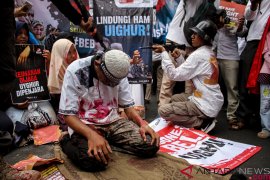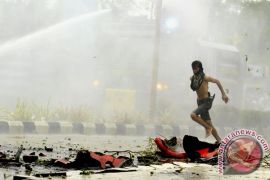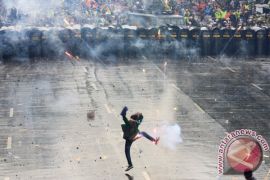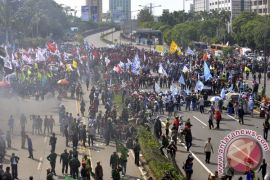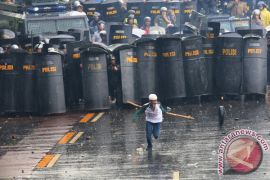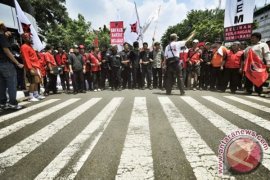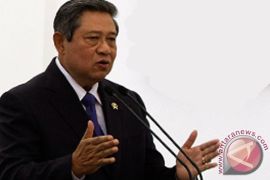The masses of workers came from three labor union confederations: the Indonesian Workers Union Confederation (KSPI) under Siad Ibal, the All Indonesian Workers Union Confederation (KSPSI) under Andi Gani, and the All Indonesian Laborers Confederation (KSBSI) under Mudhofir.
They "besieged" the Presidential Palace and urged the government to fulfill their 10-point demands, which included lowering the prices of basic necessities and fuel oil.
The demonstrators voiced their objection to the layoffs carried out by employers on grounds of the rupiah depreciation and the economic slowdown.
They also rejected the influx of foreign workers into the country and urged to annul the requirement for foreign workers to master the Indonesian Language.
Regarding wages in 2016, the workers demanded a minimum increase of 22 percent from the previous minimum wage in a bid to increase their purchasing power.
They also rejected the Governments Draft Regulation on Wages, which is only based on inflation and gross domestic income.
The demonstrators also demanded a revision in the decent living standard, which has become the basis for the formulation of the wages of workers and an increase from 60 points to 84 points.
The workers also sought a revision in the Pension Assurance of the Social Security Management Agency for Employment (BPJS Ketenagakerjaan). They demanded that the workers should be provided similar pension benefits as those offered to civil servants and not merely Rp300 thousand per month.
Regarding the performance of the Social Security Management Agency for Health (PBJS Kesehatan), the demonstrators urged the agency to improve its services and eliminate the INA CBGs (Indonesia Case-Based Group) system and Health Ministers Regulation No. 59/2014, which leads to low hospital tariffs.
The laborers rejected a hike in the BPJS Kesehatan premium pay, calling on the government to increase the amount of budget for the recipients of the premium payment assistance (PBI) to Rp30 trillion.
They also demanded the dissolution of the Industrial Relations Court (PHI) by revising Law No. 2/2004. They viewed the PHI as serving only as a graveyard for workers.
In connection with the accident at PT Mandom Indonesia, the demonstrators demanded that the companys leaders be punished due to their negligence that led to 27 deaths and 31 other layoffs.
Besides this, the labor activists were also often criminalized wherein several of them were imprisoned, but when the employers committed any wrongdoing, the police were very slow in taking action against them.
They also urged President Joko Widodo to replace Manpower Minister Hanif Dhakiri as the minister had never taken any action in cases that involved laborers.
Finally, the demonstrators called for the elimination of modern slaveries by enacting the Law on the Protection of Household Servants. If their demands were not met, the KSPI will organize a nationwide strike.(*)
Editor: Heru Purwanto
Copyright © ANTARA 2015
